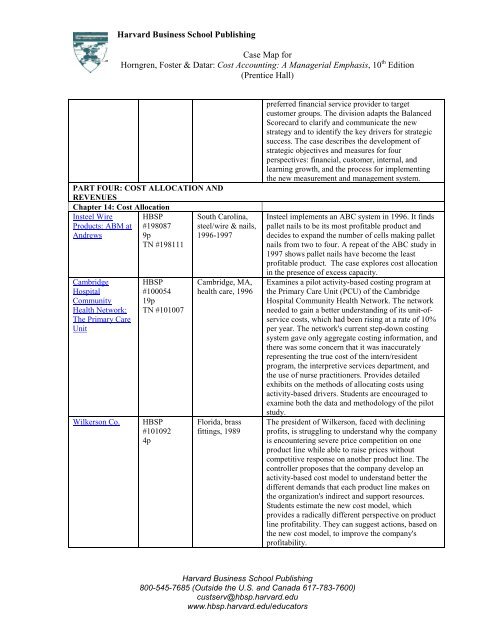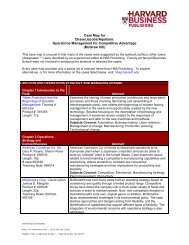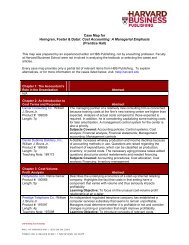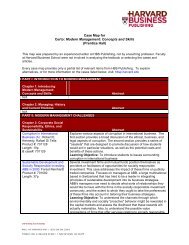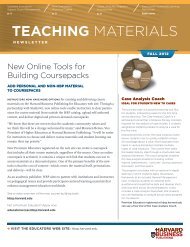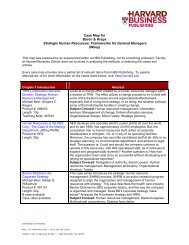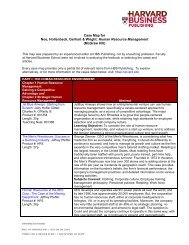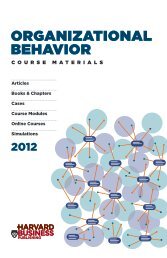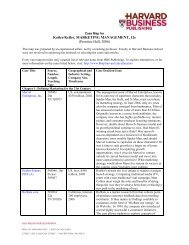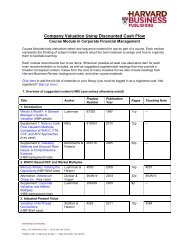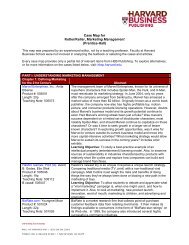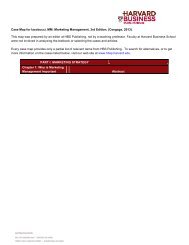Request for Information - Harvard Business School Press
Request for Information - Harvard Business School Press
Request for Information - Harvard Business School Press
You also want an ePaper? Increase the reach of your titles
YUMPU automatically turns print PDFs into web optimized ePapers that Google loves.
<strong>Harvard</strong> <strong>Business</strong> <strong>School</strong> Publishing<br />
Case Map <strong>for</strong><br />
Horngren, Foster & Datar: Cost Accounting: A Managerial Emphasis, 10 th Edition<br />
(Prentice Hall)<br />
PART FOUR: COST ALLOCATION AND<br />
REVENUES<br />
Chapter 14: Cost Allocation<br />
Insteel Wire<br />
Products: ABM at<br />
Andrews<br />
Cambridge<br />
Hospital<br />
Community<br />
Health Network:<br />
The Primary Care<br />
Unit<br />
HBSP<br />
#198087<br />
9p<br />
TN #198111<br />
HBSP<br />
#100054<br />
19p<br />
TN #101007<br />
Wilkerson Co. HBSP<br />
#101092<br />
4p<br />
South Carolina,<br />
steel/wire & nails,<br />
1996-1997<br />
Cambridge, MA,<br />
health care, 1996<br />
Florida, brass<br />
fittings, 1989<br />
preferred financial service provider to target<br />
customer groups. The division adapts the Balanced<br />
Scorecard to clarify and communicate the new<br />
strategy and to identify the key drivers <strong>for</strong> strategic<br />
success. The case describes the development of<br />
strategic objectives and measures <strong>for</strong> four<br />
perspectives: financial, customer, internal, and<br />
learning growth, and the process <strong>for</strong> implementing<br />
the new measurement and management system.<br />
Insteel implements an ABC system in 1996. It finds<br />
pallet nails to be its most profitable product and<br />
decides to expand the number of cells making pallet<br />
nails from two to four. A repeat of the ABC study in<br />
1997 shows pallet nails have become the least<br />
profitable product. The case explores cost allocation<br />
in the presence of excess capacity.<br />
Examines a pilot activity-based costing program at<br />
the Primary Care Unit (PCU) of the Cambridge<br />
Hospital Community Health Network. The network<br />
needed to gain a better understanding of its unit-ofservice<br />
costs, which had been rising at a rate of 10%<br />
per year. The network's current step-down costing<br />
system gave only aggregate costing in<strong>for</strong>mation, and<br />
there was some concern that it was inaccurately<br />
representing the true cost of the intern/resident<br />
program, the interpretive services department, and<br />
the use of nurse practitioners. Provides detailed<br />
exhibits on the methods of allocating costs using<br />
activity-based drivers. Students are encouraged to<br />
examine both the data and methodology of the pilot<br />
study.<br />
The president of Wilkerson, faced with declining<br />
profits, is struggling to understand why the company<br />
is encountering severe price competition on one<br />
product line while able to raise prices without<br />
competitive response on another product line. The<br />
controller proposes that the company develop an<br />
activity-based cost model to understand better the<br />
different demands that each product line makes on<br />
the organization's indirect and support resources.<br />
Students estimate the new cost model, which<br />
provides a radically different perspective on product<br />
line profitability. They can suggest actions, based on<br />
the new cost model, to improve the company's<br />
profitability.<br />
<strong>Harvard</strong> <strong>Business</strong> <strong>School</strong> Publishing<br />
800-545-7685 (Outside the U.S. and Canada 617-783-7600)<br />
custserv@hbsp.harvard.edu<br />
www.hbsp.harvard.edu/educators


